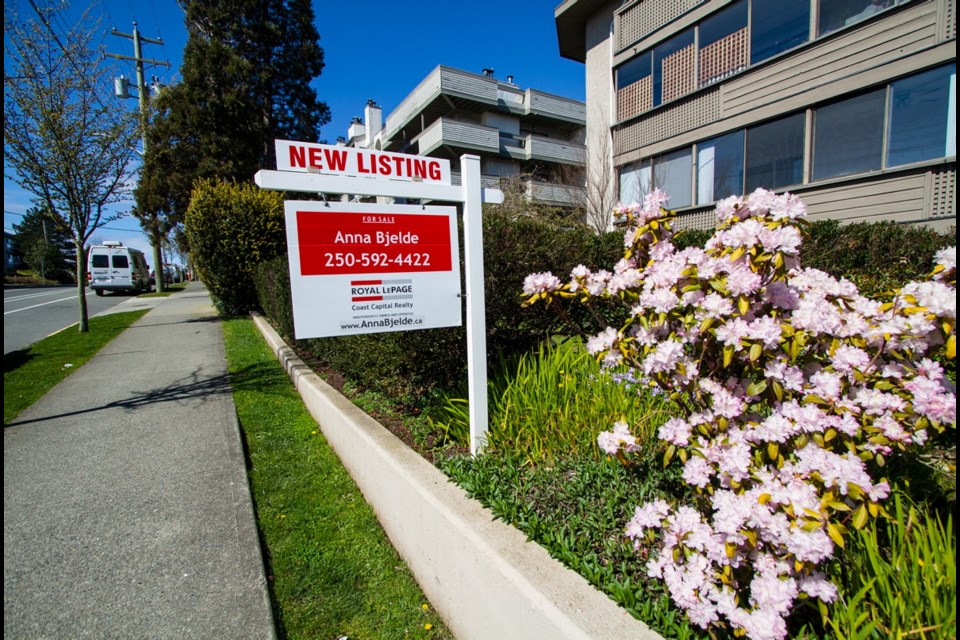The Greater Victoria real estate market felt the effects of the COVID-19 pandemic in March, according to sales figures released Wednesday, but it’s bracing for much worse this month and beyond.
According to the Victoria Real Estate Board, home sales took a hit in the second half of March. Anecdotal reports suggest new protective measures around showings and open houses, coupled with turmoil in the financial markets, could mean sales are few and far between this spring.
“I don’t know that it’s going to come to a grinding halt, but I know we are definitely going to see a slowdown,” said board president Sandi-Jo Ayers. “It will be interesting to see what our numbers look like 30 days from now.”
Current figures could be a harbinger of things to come. Last month, 608 properties were sold in the region, a five per cent drop from the 640 sold at the same time last year.
“Obviously, we were down a bit from last year, and the majority of the business we saw in March 2020 seemed to be in the first two weeks, then the slowdown began,” Ayers said. “But it’s not a complete stop by any means. Sales still continue to happen, and there are people who still have to buy and sell.”
Some real estate agents have confirmed that, in recent weeks, deals that looked solid have fallen through. In some cases, buyers have had to reconsider their financial positions, given the volatility of the stock markets, some have had to reconsider taking on mortgages and some sellers have been unwilling or unable to reduce their prices.
“I haven’t heard a lot of that, to be honest, but I have heard a few stories and there may be more of that to come,” Ayers said.
“There are people who are having a second thought about whether or not they want to take money out of their [savings], or maybe they can’t.”
Despite the turmoil, home prices remained strong in the region, with the benchmark sale price of a single-family home in the core (Victoria, Oak Bay, Saanich, Esquimalt, View Royal) hitting $877,700 in March, up from $836,100 last year. Condominium prices in the core increased 4.8 per cent over the past year to $531,900.
Ayers said it’s impossible to say where the market is heading, noting the world has changed. While the board expected the downturn, it doesn’t know how deep the drop will be, nor how long it will last.
There are as many opinions on what will happen to home-pricing as there are real estate agents, Ayers said. “We’re in uncharted territory. Had we chatted at the beginning of March, I’d say we were having a busy spring and there were multiple offers [on homes], and then the world changed. Now we are all wondering what the impact will be.”
Last month showed a drop in the number of available properties, with the region’s inventory dipping 7.5 per cent to 2,252 active listings.
That could change significantly in April and May, however, as Ayers notes the economic turmoil could force some people’s hands.
“I think there are probably going to be people who will, unfortunately, be forced to possibly sell, given the economic impact on families, which may increase inventory,” she said. “Then again, it’s too early to really say.”
What she can say is that it’s no longer business as usual, especially when it comes to the way home sales are carried out. Agents have been told not to hold open houses and to discourage in-person viewings unless absolutely necessary. If there are viewings, agents are told to ensure buyers touch nothing in the house.
Agents are being encouraged to run virtual open houses, and to ensure all transactions and administration are done electronically.
“This is a time to ensure our clients are safeguarded, as well as to ensure that our community stays healthy,” said Ayers, noting agents are using technology more than ever to buy and sell homes.
She said it’s not unheard of for buyers from outside B.C. or the country to purchase a property without having seen it in person by viewing virtual tours.
“It would have been rare, but now, as we go forward, we may see more of that.”



